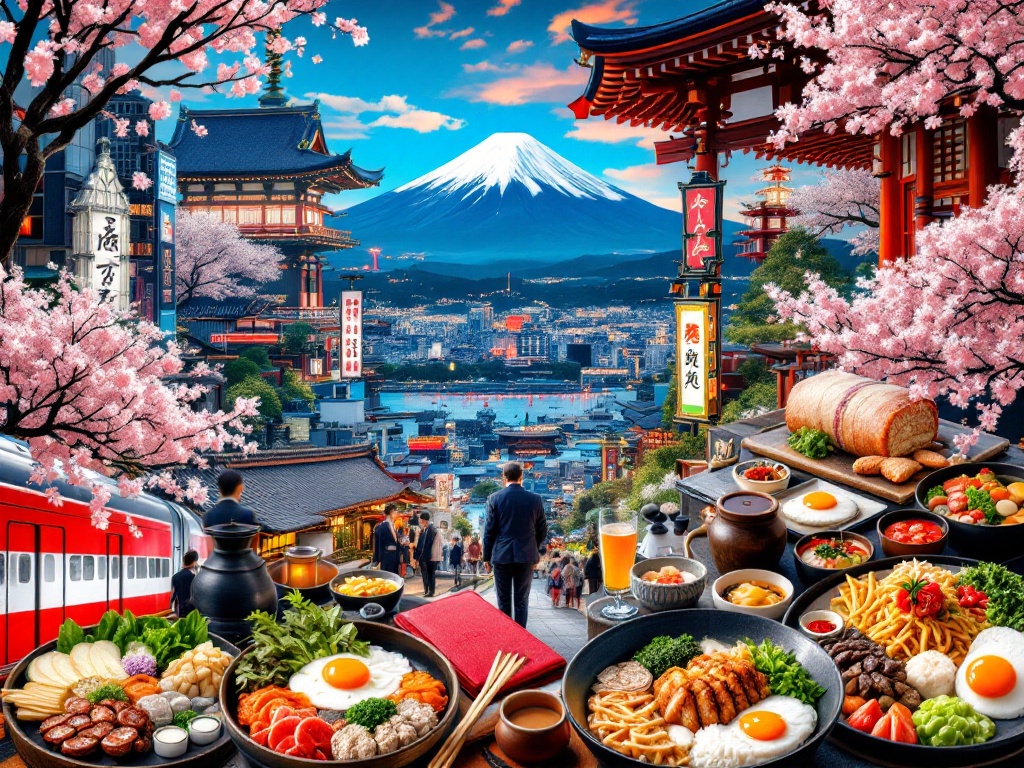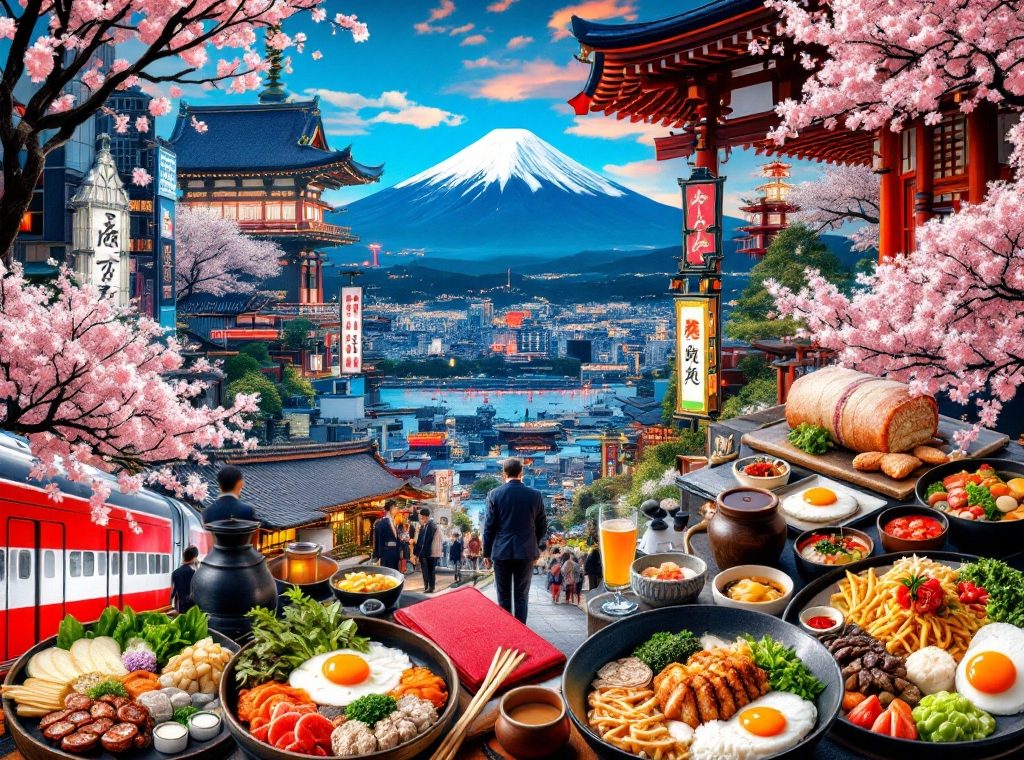Traveling to Japan for the First Time: Complete Guide
Dreaming of exploring Japan? From the bustling streets of Tokyo to the serene temples of Kyoto, your unforgettable adventure starts here. This guide provides essential tips for first-time travelers, covering everything from navigating the efficient public transport system and embracing the cash-based society to immersing yourself in local customs and savoring the diverse cuisine. Discover how to maximize your trip with the Japan Rail Pass, explore must-see attractions like Mount Fuji and vibrant cherry blossoms, and choose the perfect accommodation, whether a traditional Ryokan or a modern hotel. Start planning your dream Japan trip today!
Important information

- Cash is the preferred payment method, especially in smaller establishments. Carry Japanese Yen (JPY) and be aware that credit card acceptance is less common in rural areas.
- Japan’s public transportation, particularly its rail system, is highly efficient. Utilize the Japan Rail Pass for cost-effective travel between cities. Apps like HyperDia or Japan Travel by Navitime are useful for route planning.
- Learning basic Japanese phrases and researching cultural etiquette will enhance your interactions and show respect. For example, bowing is the customary greeting, and removing shoes indoors is expected.
- Accommodation options range from traditional Ryokans (for a cultural experience) to modern hotels and budget-friendly capsule hotels. Book in advance, particularly during peak seasons.
- Consider travel insurance to cover unexpected events and medical expenses, as healthcare can be costly for visitors. Also, check travel advisories before your trip.
Essential Information for First-Time Travelers to Japan
Planning a trip to Japan? Here’s what you need to know for an unforgettable experience:
Research Japanese customs and learn basic phrases. This will enhance your interactions with locals and demonstrate respect for their culture.
Master public transport. The Japan Rail Pass is highly recommended for efficient and cost-effective intercity travel.
Carry cash. While some establishments accept credit cards, cash is still the preferred payment method in many places.
Explore local restaurants. Japan offers incredible culinary experiences, from traditional dishes to modern fusion cuisine.
Visit cultural sites. Immerse yourself in Japan’s rich history and traditions by exploring temples, shrines, and historical landmarks.
Observe local customs. Show respect by bowing and removing your shoes indoors, among other practices.
Check travel advisories and consider travel insurance. This will ensure a worry-free vacation and provide assistance in case of unexpected events.
Understanding Japan’s Safety and Security
Japan is remarkably safe, a haven for travelers who often feel comfortable exploring its cities, even at night. While generally secure, petty theft does happen, so keep an eye on your belongings, especially in crowded spaces. Be wary of potential scams. Staying informed is key to a smooth and enjoyable trip.
Travel Insurance Necessities
Travel insurance protects you from unexpected problems like medical emergencies, trip cancellations, or lost luggage. Medical care in Japan can be expensive for visitors, but a comprehensive policy covers these costs and might even pay for your flight home if needed. Events like natural disasters, political unrest, or personal emergencies can disrupt trips. Insurance can refund your prepaid expenses in these situations. It also protects against lost or stolen luggage, including valuables. Some policies cover flight delays and missed connections, helping with extra costs. Travel insurance offers peace of mind, making it a worthwhile investment for your trip.
Dealing with Japan’s Cash-Driven Society
Cash is king in Japan, the preferred payment method. While credit cards are becoming more common in larger establishments, many smaller shops, markets, and restaurants still primarily operate on a cash basis. Therefore, carrying sufficient Japanese Yen is essential for travelers to seamlessly purchase goods and fully experience all that Japan has to offer.
Best Times to Visit Japan
Planning a trip to Japan? Spring (March to May) boasts comfortable temperatures and the iconic cherry blossoms. If vibrant colors are more your style, autumn (September to November) offers breathtaking fall foliage. Japan has something for everyone, no matter the season.
Cherry Blossom Season Highlights
Japan’s cherry blossom season, a beloved time for tourists, typically graces the country from late March to early May. However, the precise timing varies annually, depending largely on weather patterns. The breathtaking display begins in southern Kyushu before gradually drifting north towards Hokkaido. This fleeting spectacle of vibrant pink and white blossoms transforms both urban landscapes and rural countryside. The Japanese commemorate this natural wonder with *hanami* festivals. To witness peak blooms, consider consulting viewing forecasts when planning your trip.
Autumn Leaves and Other Seasonal Attractions
Japan transforms dramatically in autumn, with landscapes ablaze in vibrant hues of red, orange, and gold, creating truly picturesque scenes.
Autumn is also a festival season in Japan, celebrating traditions through vibrant displays of art and culture, offering a unique immersion into Japan’s rich heritage and captivating cultural expressions.
Planning Your Japan Itinerary
Planning your dream trip to Japan? Start with the iconic trio: Tokyo, Kyoto, and Osaka. Design a balanced itinerary that blends cultural experiences, vibrant shopping streets, delicious cuisine, and stunning scenery. A daily schedule will optimize your time. For travel between cities, the Japan Rail Pass offers great value.
Before You Go
- Learn basic Japanese phrases for better communication.
- Research Japan’s efficient public transport system.
- Familiarize yourself with dining etiquette; tipping is not customary.
- Practice using chopsticks for an authentic culinary experience.
- Check travel advisories and secure travel insurance.
- Start planning six months ahead for a seamless trip.
During Your Trip
- Explore the vibrant cities of Tokyo, Kyoto, and Osaka.
- Immerse yourself in the rich Japanese culture.
- Indulge in the diverse and exquisite cuisine.
- Visit breathtaking sights and landmarks.
- Enjoy shopping in bustling districts.
- Utilize the Japan Rail Pass for cost-effective intercity travel.
Recommended Travel Length for First-Time Visitors
A two-week trip to Japan is ideal for first-time visitors, offering ample opportunity to discover multiple cities and immerse yourself in the rich culture. Experience the vibrant energy of Tokyo’s markets and the serene atmosphere of a Kyoto temple. Careful planning is essential to make the most of your journey. A Japan Rail Pass can streamline travel between cities, simplifying your exploration. Below are some steps you can follow to make the most of your trip.
Purchase a Japan Rail Pass. This will save you a significant amount of money on transportation.
Book accommodations in advance, especially during peak seasons. This will help find the best deals and ensure you have a place to stay.
Plan your itinerary carefully. Research the different cities and decide which ones you want to visit.
Learn some basic Japanese phrases. This will enhance your interactions with locals.
Pack light. You’ll be doing a lot of walking and moving around, so it’s best to travel with minimal luggage.
Grouping Activities by Location
Maximize your sightseeing by grouping activities by location. This saves valuable travel time and ensures you don’t overlook nearby attractions.
Tokyo
- Imperial Palace,
- Sensō-ji Temple,
- Tokyo National Museum.
Kyoto
- Fushimi Inari Shrine,
- Kiyomizu-dera Temple,
- Arashiyama Bamboo Grove.
This efficient approach enhances your travel experience, letting you see more while traveling less.
Transportation Options in Japan
Traveling in Japan is easy and convenient, thanks to a variety of transportation options. The well-known railway system is famous for its punctuality and extensive network, connecting major cities throughout the country. For shorter trips, buses provide a more budget-friendly choice, reaching even remote areas not accessible by train. Taxis are readily available, especially in urban areas, although they can be costly. For traveling longer distances, such as between islands, domestic flights are a practical option. For frequent train travelers, the Japan Rail Pass offers significant cost savings. Lastly, apps like Hyperdia and Japan Transit Planner provide helpful route planning and real-time updates, ensuring smoother travels.
Getting Around Japan
- Trains: known for punctuality and a comprehensive network connecting major cities.
- Buses: a cost-effective option, especially for shorter distances and reaching remote areas.
- Taxis: easily accessible in cities, but can be more expensive.
Travel Tips
- Domestic Flights: practical for long distances, such as inter-island travel.
- Japan Rail Pass: a money-saving option for frequent train travelers.
- Travel Apps: use apps like Hyperdia and Japan Transit Planner for route planning and real-time updates.
Exploring Japan’s Extensive Railway System
Japan’s railway system offers incredible convenience and efficiency for travelers. Its extensive network connects major cities and regions, ensuring seamless travel thanks to the renowned punctuality of its trains.
Overview of the Japan Rail Pass
The Japan Rail Pass offers unlimited access to Japan Railways (JR) trains, including the Shinkansen bullet trains, express trains, and local lines. Ideal for tourists, this cost-effective pass simplifies travel throughout Japan. It is available in 7, 14, or 21-day options, and offers both Green (first class) and Ordinary class seating. Activate it upon arrival and enjoy travel on select JR buses and ferries as well.
Navigating Public Transportation: Trains, Buses, and Taxis
Japan’s public transportation system offers exceptional travel experiences, encompassing trains, buses, and taxis. The highlight is the Shinkansen, the renowned bullet train, connecting major cities at incredible speeds. For urban travel, subways and local train lines provide convenient access, while buses connect cities and towns nationwide, reaching areas beyond train lines. Taxis are readily available, especially in cities. Prepaid IC cards like Suica or Pasmo simplify travel, usable on trains, subways, and buses. These are easily purchased and reloaded at stations. For extensive intercity travel, the Japan Rail Pass offers substantial savings. Numerous travel apps and websites offer route planning and real-time updates. English signage is common in stations and on buses, facilitating easy navigation.
Accommodation Choices in Japan
Planning a trip to Japan? You’ll discover a variety of accommodations to fit your budget and travel style.
Traditional Stays
Experience authentic Japanese culture at a ryokan. Enjoy traditional tatami mats, unwind in communal baths, and savor exquisite kaiseki meals.
Modern Comfort
If you prefer modern amenities, choose from numerous hotels offering Western-style beds, private bathrooms, and other familiar comforts.
Budget-Friendly Options
For budget travelers, capsule hotels offer a unique experience with compact and affordable sleeping pods, perfect for short stays. Hostels and guesthouses are also readily available.
Vacation Rentals
Enjoy the comforts of home with a vacation rental. These can provide more space and flexibility for families or larger groups.
Expect prices to typically range from $50 to $200 per night, although this can vary. Booking in advance is highly recommended, especially during peak seasons such as the cherry blossom spring or the colorful autumn months. Secure your accommodations and prepare for an unforgettable Japanese adventure.
Traditional Ryokans vs Modern Hotels
Traditional Ryokans
Experience authentic Japanese culture in a Ryokan. Traditional features include tatami mats, onsen baths, and kaiseki meals. Ryokans prioritize omotenashi, heartfelt Japanese hospitality, offering a truly immersive cultural experience.
- Tatami mat rooms,
- Onsen baths,
- Kaiseki meals.
Modern Hotels
Enjoy familiar comforts and conveniences in modern Japanese hotels. Amenities often include private bathrooms, diverse dining options, fitness centers, and business facilities. Hotels provide a more standardized, international experience.
- Private bathrooms,
- Varied dining options,
- Fitness centers and business facilities.
Choose a ryokan for cultural immersion or a modern hotel for convenience and familiarity. Each offers a unique perspective on Japanese hospitality.
Experience Capsule Hotels
Looking for affordable and unique accommodations? Consider capsule hotels, offering compact, pod-like rooms perfect for budget travelers. These efficient spaces provide essential amenities, such as Wi-Fi and shared bathrooms. Popular in bustling Japanese cities like Tokyo, Osaka, and Kyoto, capsule hotels appeal to both business travelers and tourists with their affordability and clever use of space.
Must-Visit Tourist Attractions in Japan
Experience Tokyo’s breathtaking panorama from the iconic Tokyo Tower.
Journey back in time at Kyoto’s historic temples, testaments to Japan’s rich heritage.
Reflect on peace at the Hiroshima Peace Memorial Park, a powerful symbol.
Witness the energetic pulse of modern Tokyo at Shibuya Crossing, the world’s busiest intersection.
In Nara Park, nature and culture intertwine, where friendly deer roam freely.
Behold Mount Fuji’s stunning natural beauty, Japan’s highest peak.
Immerse yourself in traditional Japan within Kyoto’s Gion district, a unique geisha district experience.
Exploring Mount Fuji and Hakone
Mount Fuji, Japan’s highest peak, is a UNESCO World Heritage site and a powerful symbol of the country. Its symmetrical cone is instantly recognizable and inspires awe. The nearby mountain resort town of Hakone offers stunning views of this iconic volcano. Hakone is also famous for its hot springs, known as onsen. Visitors can enjoy a cruise on Lake Ashi with Mount Fuji as a backdrop, or ride the Hakone Ropeway for breathtaking views of volcanic hot springs. Art lovers will appreciate the Hakone Open-Air Museum, which features contemporary sculptures beautifully displayed against the natural canvas of mountains and lush scenery.
Visiting Shrines and Temples
Japan offers a captivating journey into its spiritual heritage through its numerous peaceful shrines and temples. These sacred spaces boast tranquil atmospheres and intricate details, captivating the senses.
Fushimi Inari Shrine, Kyoto
Kyoto’s Fushimi Inari Shrine is renowned for its seemingly endless procession of vibrant red torii gates. It’s a prime example of traditional Japanese architecture and a popular destination.
Senso-ji Temple, Tokyo
Senso-ji Temple, Tokyo’s oldest temple, stands as another must-see destination. Respectful attire and proper etiquette are essential when visiting these revered locations.
Understanding Japanese Culture and Etiquette
In Japan, a polite bow is the customary greeting.
Remember to slip off your shoes before entering homes and some businesses.
Public spaces call for quieter conversations.
Avoid sticking chopsticks upright in rice bowls, as this gesture is considered rude.
Sharing food is a common and appreciated custom.
Gift-giving is also traditional, so a small present for your hosts is a thoughtful gesture.
Tipping isn’t necessary.
Social Customs and Tipping Etiquette
In Japan, it’s polite to remove your shoes before entering homes, traditional restaurants, temples, and occasionally some businesses. This practice reflects respect and helps maintain cleanliness.
Unlike many other countries, tipping is not customary in Japan and can sometimes cause confusion or even offense. So, avoid tipping in any situation, including restaurants, taxis, and hotels.
Handling the Language Barrier
Venturing beyond Japan’s bustling cities offers an exciting but sometimes challenging linguistic landscape. Outside major urban centers, restaurant menus often appear solely in Japanese, transforming ordering into a delightful culinary gamble. While translation apps and phrasebooks can be invaluable tools, mastering basic greetings such as “sumimasen” (excuse me) and “arigato” (thank you) significantly enhances communication. Many hotels and tourist centers do offer multilingual assistance. However, even simple gestures or pointing at pictures can effectively convey your needs.
Local Cuisine and Dining Options
Japanese cuisine offers a world of exciting flavors, from the delicate artistry of sushi and tempura to the comforting warmth of ramen and udon. While vegetarian options can sometimes be limited, adventurous eaters can discover many delicious dishes. For a quick and easy meal, convenience stores stock a surprising variety of snacks and meals. To experience truly authentic Japanese cuisine, explore the diverse menus of local restaurants.
Japanese Cuisine: Must-Try Dishes
Japanese cuisine offers a diverse culinary experience. From fresh sushi to comforting ramen, there’s a dish for everyone. For a crispy treat, try tempura. Okonomiyaki, a savory pancake, is another favorite. Explore regional specialties like Hiroshima-style okonomiyaki and Hokkaido’s seafood. Don’t miss the street food scene with takoyaki and taiyaki. Indulge in traditional sweets like mochi and matcha desserts.
Must-Try Dishes
- Sushi: Fresh seafood and vinegared rice,
- Ramen: Flavorful noodle soup with regional variations,
- Tempura: Battered and deep-fried seafood and vegetables,
- Okonomiyaki: Savory pancake,
- Takoyaki: Octopus balls,
- Taiyaki: Fish-shaped waffles.
Sweet Treats
- Mochi: Rice cakes,
- Matcha desserts: Various desserts incorporating matcha flavor.
Regional Specialties
- Hiroshima-style okonomiyaki,
- Hokkaido seafood.
Convenience Stores and Local Dining
Convenience stores, known as “konbini” in Japan, are ubiquitous and offer a diverse selection of ready-to-eat meals, snacks, and drinks, often at prices lower than restaurants. Popular choices include onigiri (rice balls), sandwiches, instant ramen, and bento boxes. Many konbini provide microwaves and hot water dispensers for heating food. Beyond food, these stores offer a range of services, from ATMs and bill payment to photocopying, making them a true one-stop shop for travelers and locals alike.
Travel Costs and Budgeting Tips
Traveling in Japan can be tailored to any budget. Backpackers can explore comfortably on $50-$100 per day. Mid-range travelers should budget $100-$300 daily. For a luxurious experience, expect to spend upwards of $300 a day.
Accommodation
Hostels offer budget-friendly options from $25 per night. For a more luxurious stay, high-end hotels are available from $200 and up.
Food
Budget travelers can savor delicious meals for around $20 a day. Mid-range restaurant dining typically costs $50 or more per day.
Transportation
Local trains and buses provide cost-effective travel. For faster travel, consider the Shinkansen bullet train, but be prepared for higher fares, especially over long distances.
Managing Your Budget
Utilize budgeting apps or spreadsheets to track your spending. Factor in accommodation, food, transportation, activities, and souvenirs. Explore free activities such as visiting parks and temples to maximize your budget.
Estimating Daily Expenses
Plan your dream trip to Japan with a budget that suits your style. Backpackers and budget-conscious travelers can comfortably explore Japan on ¥7,000–¥10,000 per day, covering accommodation, food, local transport, and activities. For a more comfortable mid-range experience, a daily budget of ¥10,000–¥20,000 is recommended. If you’re seeking a luxurious Japanese adventure, expect to spend upwards of ¥20,000 per day. Enjoy delicious meals starting from ¥1,000, while fine dining experiences can cost over ¥5,000. Travel conveniently on local transport for around ¥200 to ¥500 per ride. Explore Japan’s rich culture with visits to attractions and temples, typically costing between ¥300 and ¥1,000.
Currency and Banking in Japan
Planning a trip to Japan? Remember to bring Japanese Yen (JPY), as cash is still the preferred payment method. This is especially true in smaller businesses and rural areas. While credit cards are becoming more common in larger city establishments, having cash on hand is always recommended. ATMs are readily available throughout Japan, particularly in urban areas, and many accept international cards. Don’t forget to inform your bank of your travel dates to avoid any issues with using your cards abroad.
Helpful Tools and Resources for Your Trip
Streamline your Japan trip with these helpful apps:
Travel Planning
- HyperDia or Japan Travel by Navitime: plan routes and check train schedules in real time,
- Gurunavi: discover fantastic restaurants.
Communication & Connectivity
- Google Translate or DeepL: overcome language barriers,
- Airalo or Holafly: stay connected with an eSIM,
- Pocket Wi-Fi device: opt for consistent connectivity.
Free Wi-Fi is also readily available at many train stations, cafes, and convenience stores.
Travel Apps for Japan
Planning a trip to Japan? Leverage the power of travel apps to enhance your experience. For navigating Japan’s intricate rail system, Jorudan reigns supreme, simplifying navigation across the extensive network.
Train Schedules and Platform Details
HyperDia offers precise train schedules and platform details.
Offline Maps and Transit Information
Japan Travel by Navitime provides similar information with the added benefit of offline maps, perfect for data-free navigation.
Real-time Transit Updates and Directions
Google Maps is another valuable resource, delivering real-time transit updates and walking directions.
Accessing the Internet: eSIM and Wi-Fi Options
Staying connected in Japan is simple with two primary options: eSIMs and public Wi-Fi.
eSIM
An eSIM is a digital SIM card, allowing you to activate a data plan without a physical card. This convenient option eliminates the need for a physical SIM card and allows for quick activation of a data plan.
Public Wi-Fi
Public Wi-Fi hotspots are readily available in numerous locations. These include cafes, hotels, and train stations, providing convenient access points for staying connected.
Either option makes it easy to stay online throughout your trip.

















